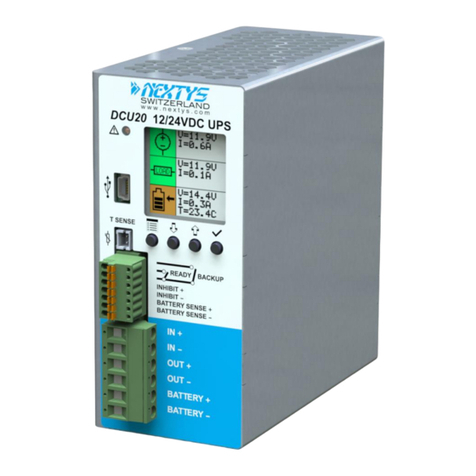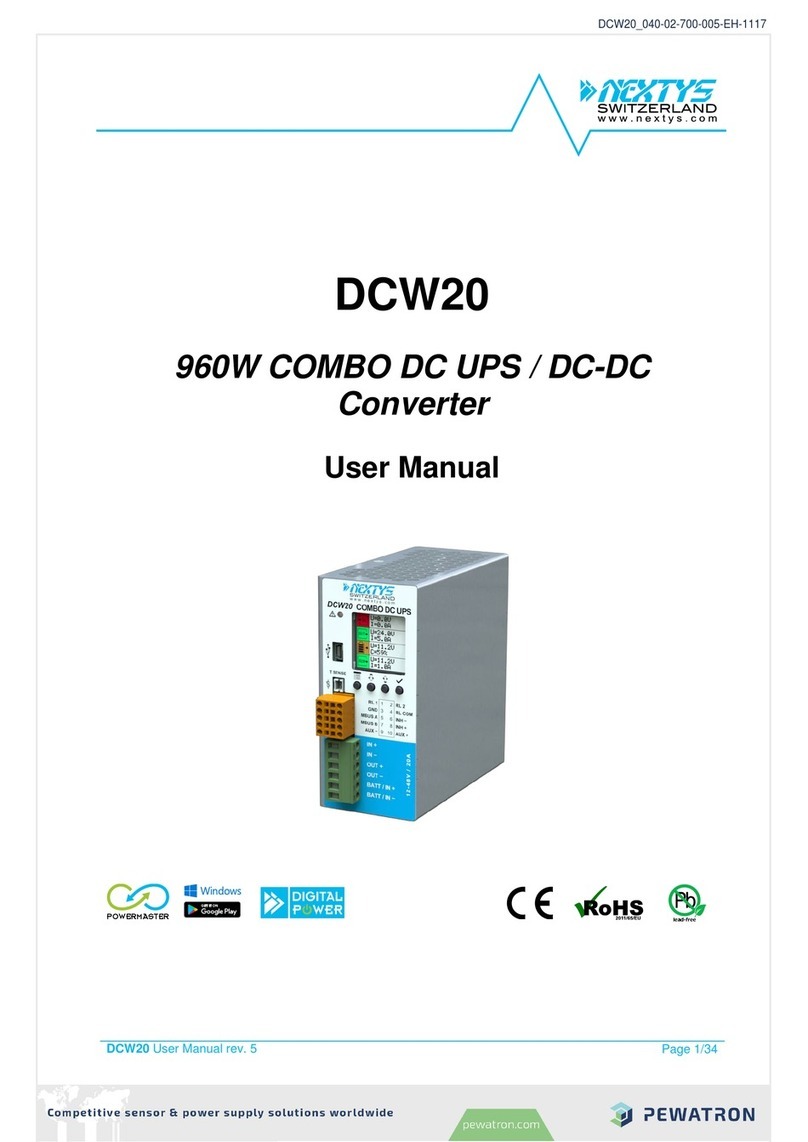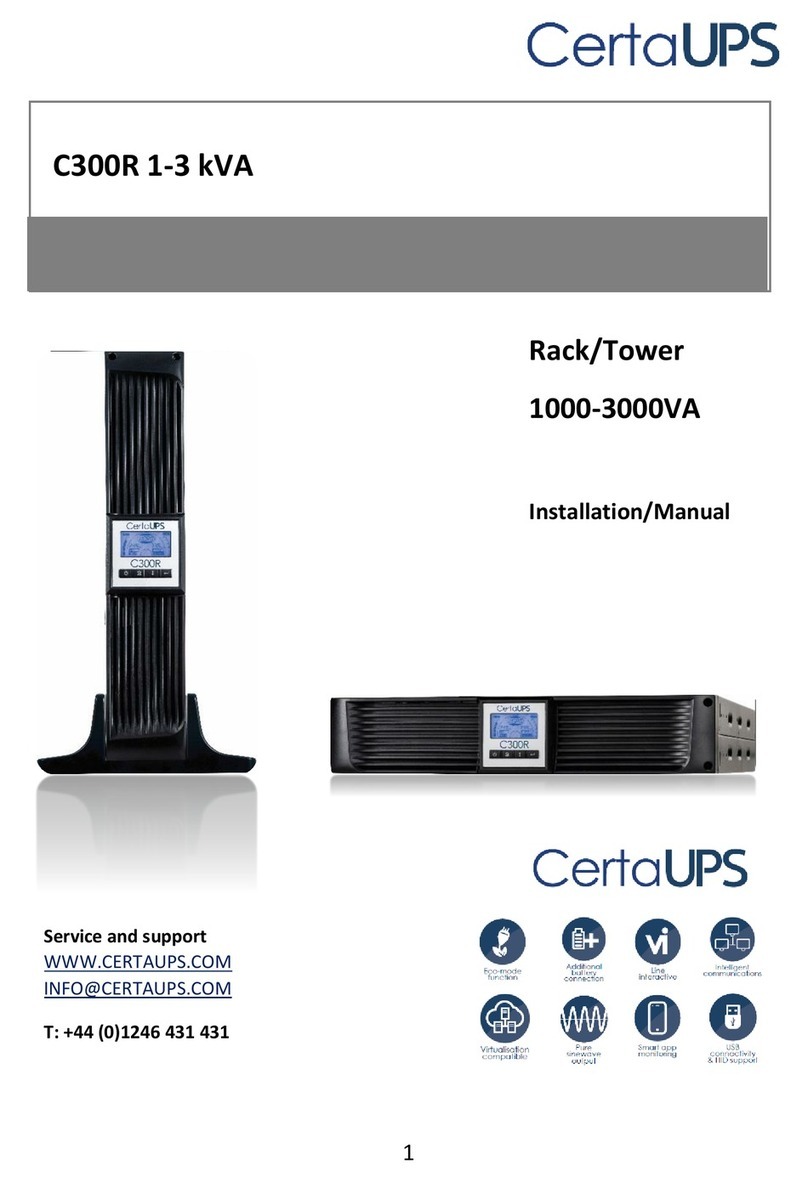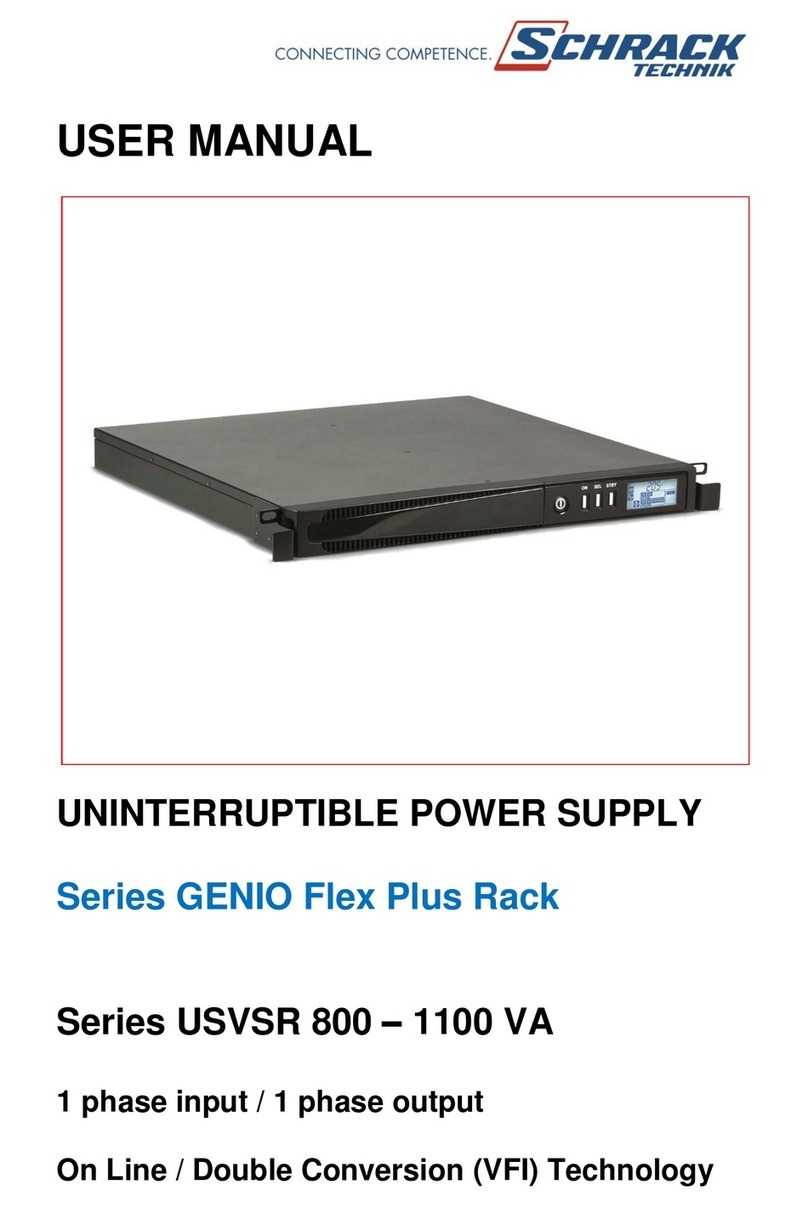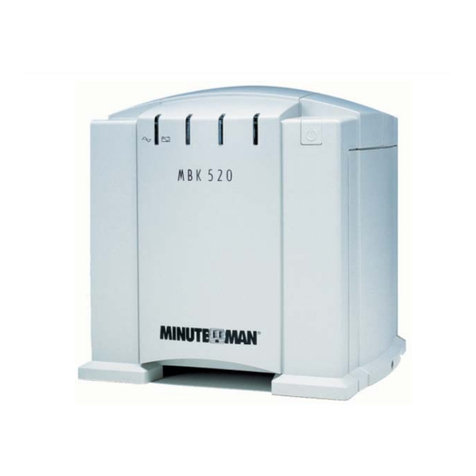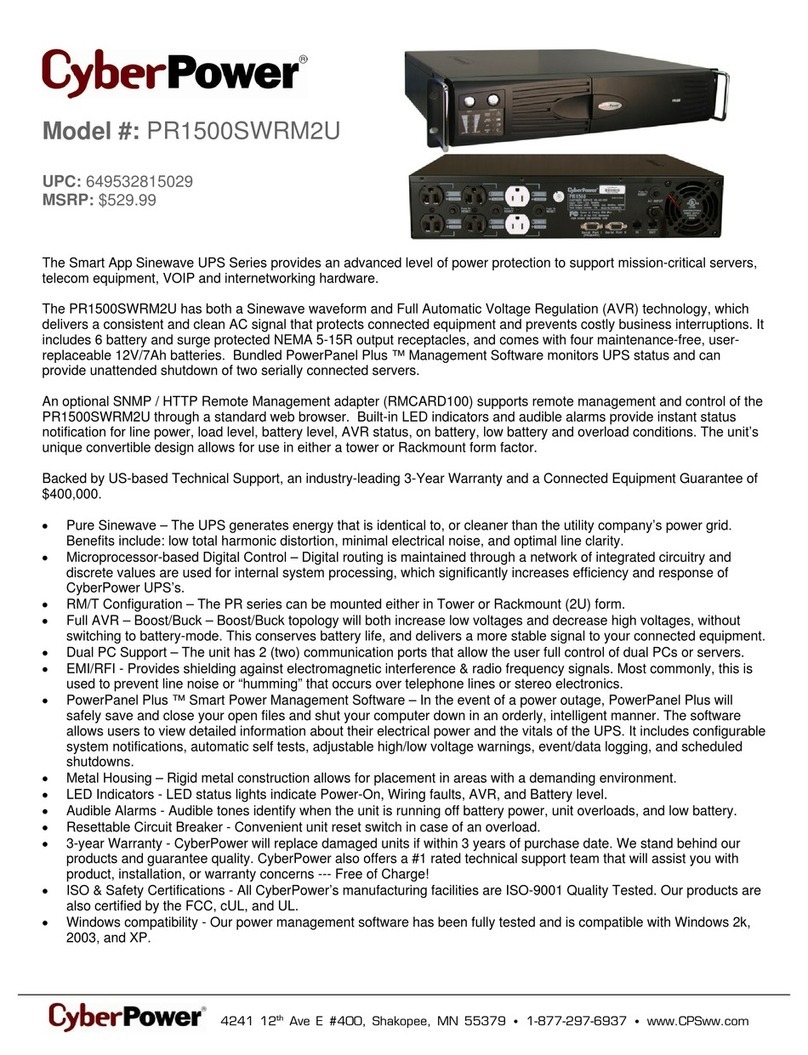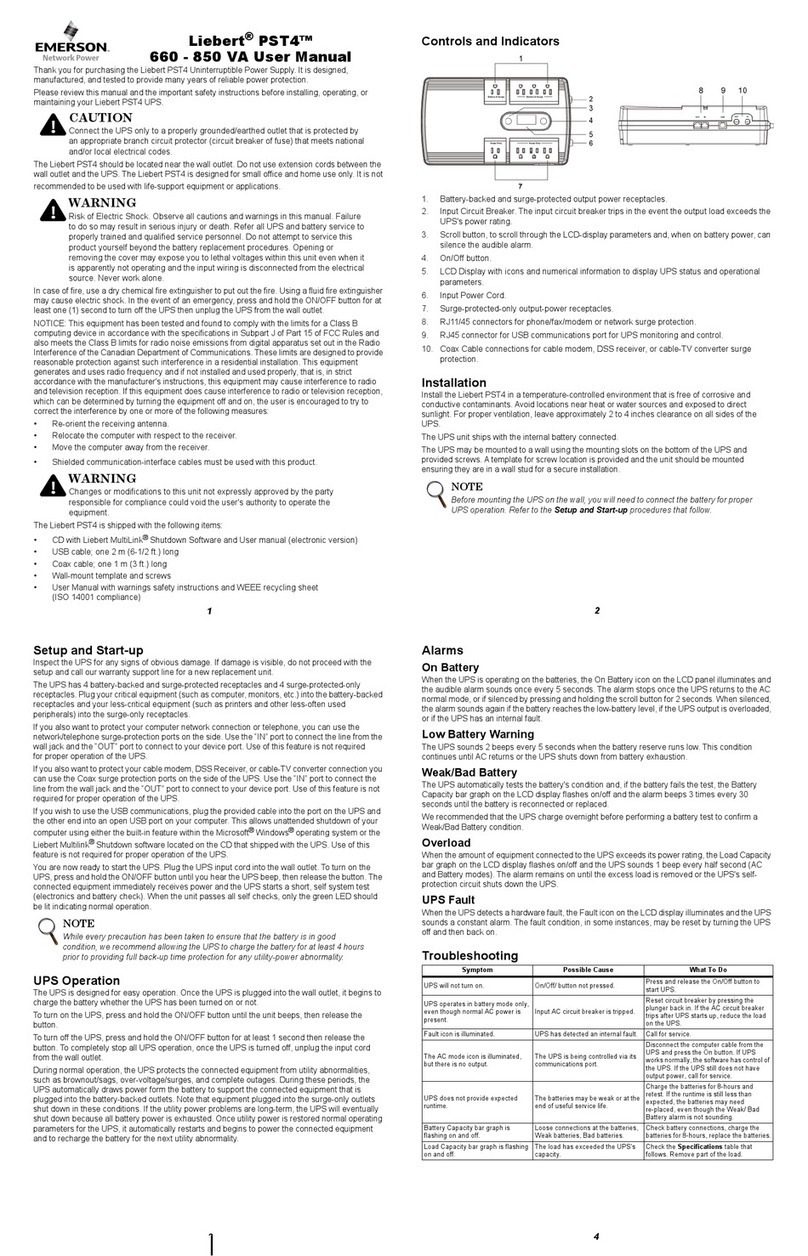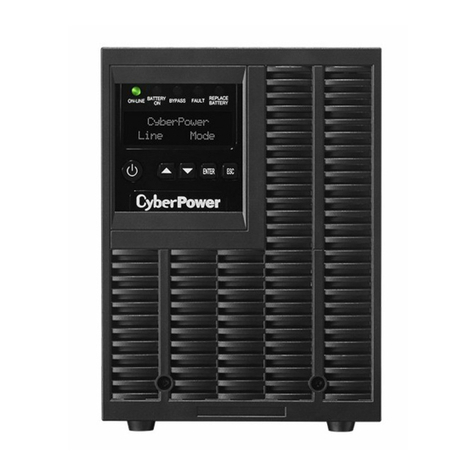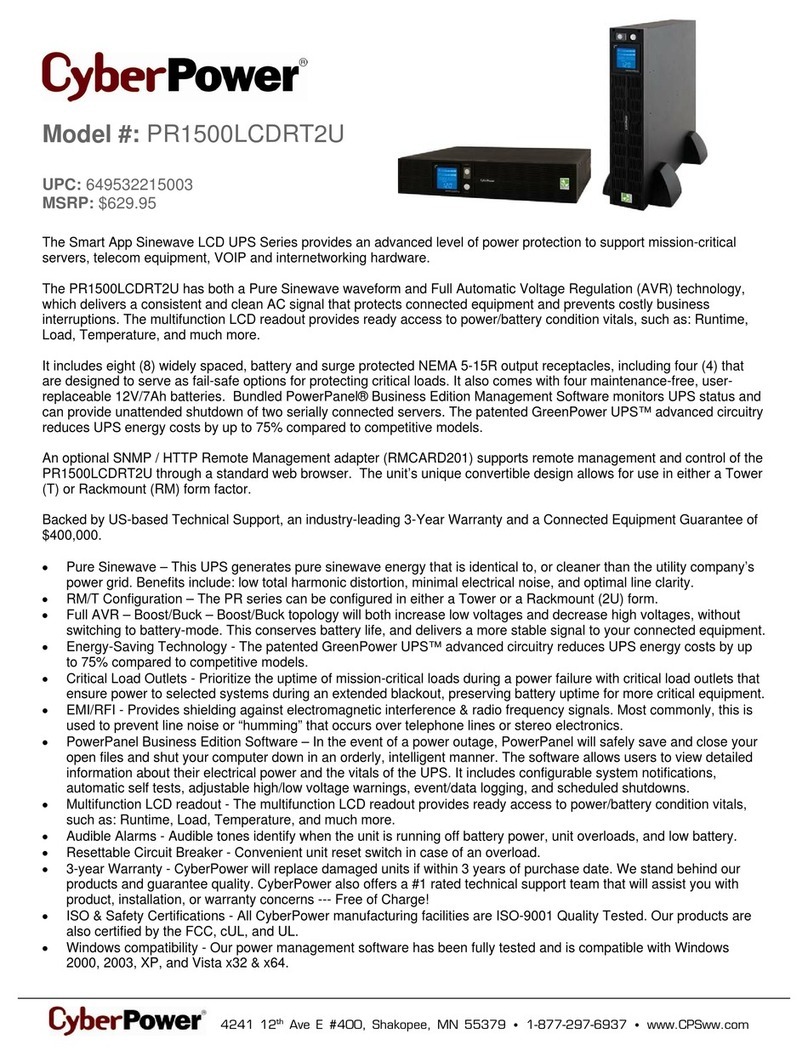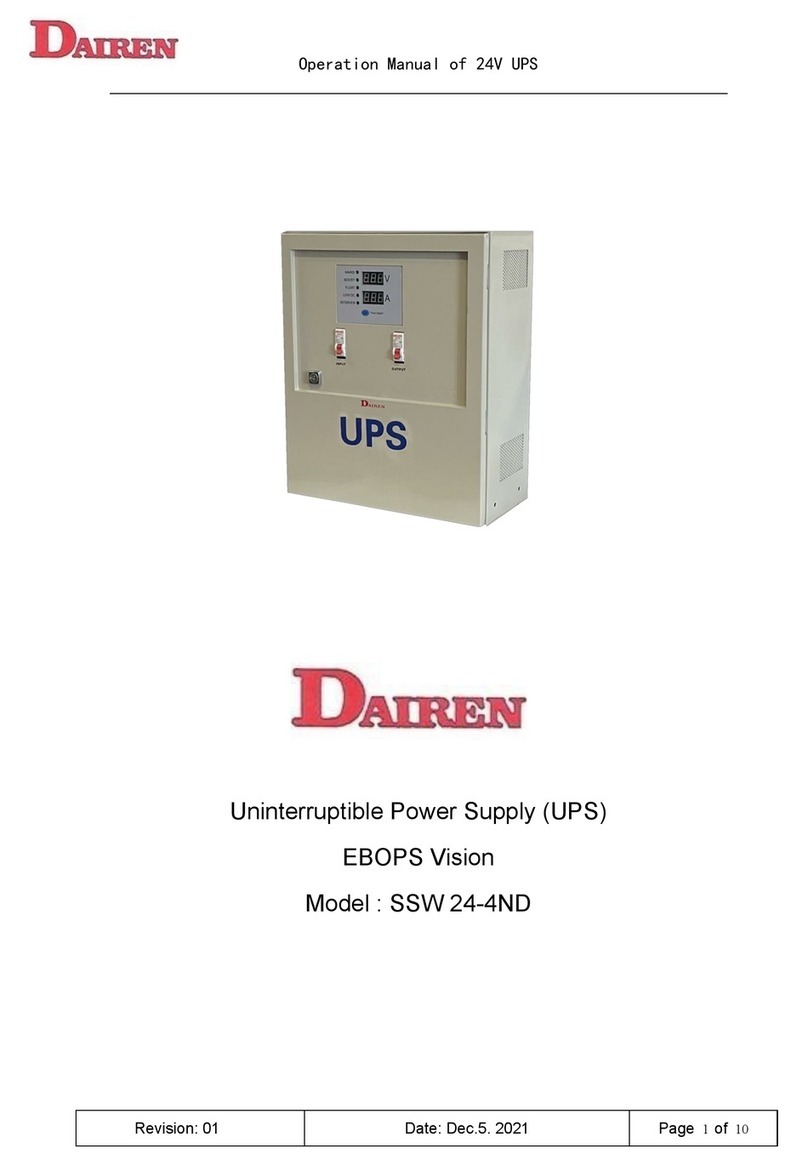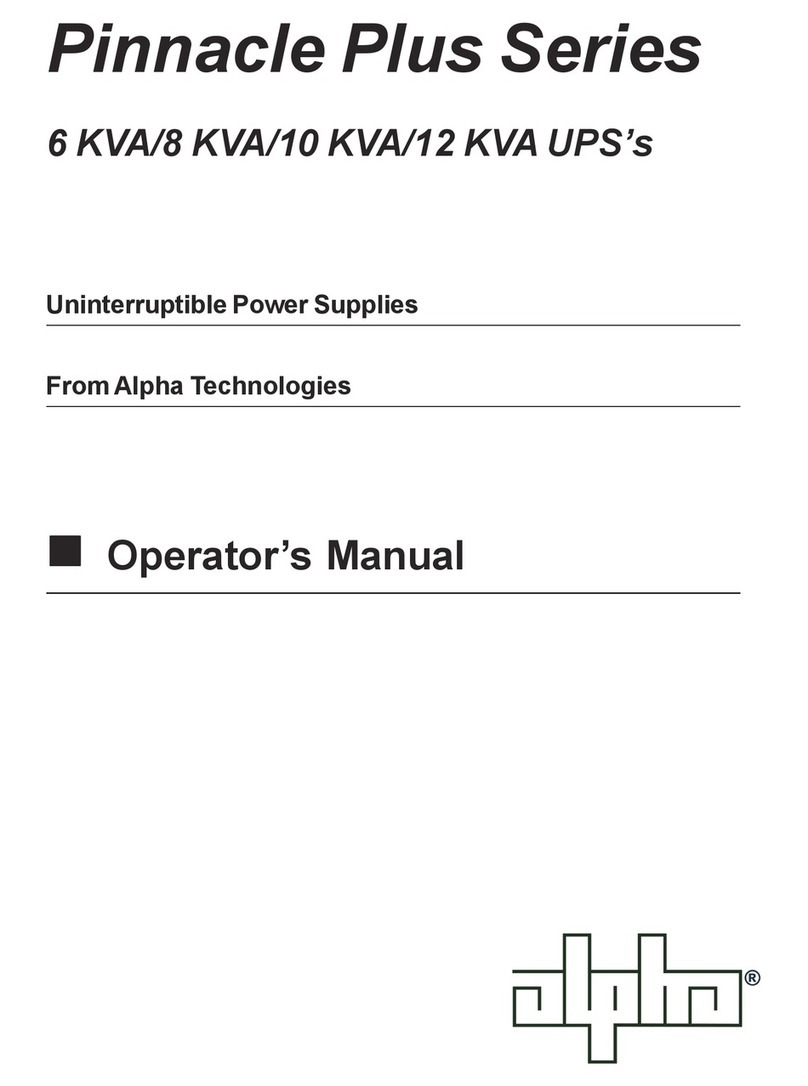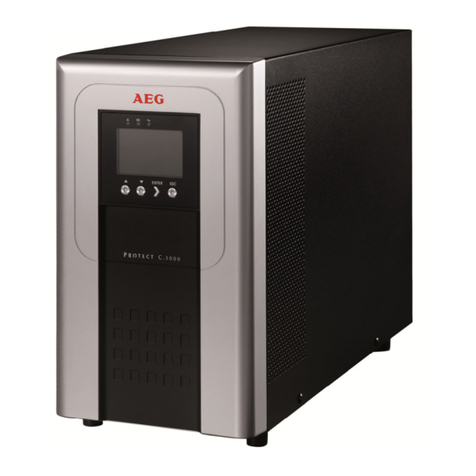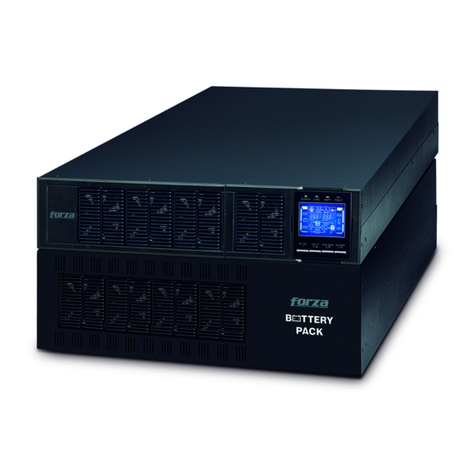nextys DCU20 How to use

1
Short Form Installation User’s Manual
Nextys SA. Via Luserte Sud 6, 6572 Quartino –Switzerland
Phone: +41-(0)91 8401446 / 8401448; Fax: +41-(0)91 8401447
Models
DCU20 –High performance DC - UPS
File No.:
I.M.DCU20
Rev.:
2.0
Use latest device Documentation, Software and Firmware to ensure reliable operation of the system
(downloadable from www.nextys.com)
READ THIS CAREFULLY BEFORE INSTALLATION!
LEGGERE ATTENTAMENTE PRIMA DELL’INSTALLAZIONE!
A LIRE ATTENTIVEMENT AVANT L’INSTALLATION!
Before operating, read this document thoroughly and retain it for
future reference.
Non-respect of these instructions may reduce performances and
safety of the devices and cause danger for people and property.
The products must be installed, operated, serviced and maintained
by qualified personnel in compliance with applicable standards
and regulations.
Don’t open the device, it does not contain replaceable
components, the tripping of the internal fuse (if included) is
caused by an internal failure.
Don’t repair or modify the device, if malfunction or failure should
occur during operation, send unit to the factory for inspection. No
responsibility is assumed by Nextys SA for any consequences
deriving from the use of this material.
Prima dell’installazione, leggere attentamente questo documento
istruzioni e conservarle per future consultazioni.
L’inosservanza delle presenti istruzioni può compromettere le
caratteristiche e la sicurezza dell’apparecchio e causare pericolo per le
persone e le cose.
Il prodotto deve essere installato, utilizzato e riparato da personale
qualificato e nel rispetto delle normative vigenti.
Non aprire il prodotto, esso non contiene componenti sostituibili, il
guasto del fusibile interno (se previsto) è causato da un guasto interno.
Non tentare di riparare o modificare il prodotto, se durante il
funzionamento si verificano guasti o anomalie, inviarlo al produttore per
il controllo.
Nextys SA non si assume nessuna responsabilità per qualunque
conseguenza derivante dall’uso di questo materiale.
Lire ces instructions avant l'installation, conserver ce manuel pour
référence future.
Défaut de se conformer à ces instructions peut affecter les
caractéristiques et la sécurité du dispositif, et causer du danger aux
personnes ou aux biens.
Les produits doivent être installés, exploités et entretenus par du
personnel qualifié et en conformité avec les règlements.
N'ouvrez pas le produit, il ne contient aucune pièce réparable, le
déclenchement du fusible interne (le cas échéant) est causé par un
défaut interne. Ne pas essayer de réparer ou modifier le produit ; si
des défaillances se produisent pendant le fonctionnement, retourner
le produit au fabricant pour inspection. Nextys SA n'assume aucune
responsabilité des conséquences éventuelles découlant de
l'utilisation des produits.
CAUTION
ATTENZIONE
AVVERTISSEMENT
RISK OF BURNS, EXPLOSION, FIRE, ELECTRICAL SHOCK, PERSONAL
INJURY.
Never carry out work on live parts! Danger of fatal injury! The
product’s enclosure may be hot, allow time for cooling product
before touching it. Do not allow liquids or foreign objects to enter
into the products.
To avoid sparks, do not connect or disconnect the device before
having previously turned-off input power and wait for internal
capacitors discharge (minimum 1 minute).
RISCHIO USTIONI, ESPLOSIONE, INCENDIO, SCOSSA, LESIONI GRAVI.
Non effettuare mai operazioni sulle parti sotto tensione! Pericolo di
lesioni letali! Il contenitore può scottare, lasciar quindi raffreddare il
dispositivo prima di toccarlo. Non far entrare liquidi o oggetti estranei
nel dispositivo.
Per evitare scintille, non collegare o scollegare l'apparecchiatura prima
di avere tolto tensione di ingresso e prima che sia avvenuta la scarica
dei condensatori interni (min. 1 minuto).
RISQUE DE BRULURES, EXPLOSION, INCENDIE, ELECTROCUTION,
DOMMAGE AUX PERSONNES.
Ne jamais effectuer des opérations sur les parties sous tension!
Danger de mort! Le boîtier peut produire des brûlures, le laisser
refroidir avant de toucher l'appareil. Ne faire pas pénétrer des
liquides ou des corps étrangers dans l'appareil. Pour éviter des
étincelles, ne pas connecter ou déconnecter l'équipement jusqu'à ce
que la tension d'entrée a été supprimée et avant qu'il n'ait eut lieu la
décharge des condensateurs internes (minimum 1 minute).
INTENDED USE
USO PREVISTO
UTILISATION
These are isolated devices suitable for SELV and PELV circuitry and
are designed to be mounted on DIN rail and installed inside a
protective enclosure. They are intended for general use such as in
industrial control, communication, and instrumentation
equipment.
Don’t use these devices in applications where malfunction may
cause injury or death.
I dispositivi sono isolati, adatti per applicazioni SELV e PELV, sono dotati
di aggancio per il montaggio su guida DIN all’interno di quadri elettrici o
contenitori di protezione, per l’utilizzo con controllori industriali, unità
di comunicazione o apparecchi di misura.
Non utilizzare in applicazioni in cui un eventuale guasto può comportare
rischio di lesioni o di morte.
Les produits sont isolés, appropriés pour les circuits TBTS et TBTP et
sont équipés d'un crochet pour montage sur rail DIN dans des
armoires ou conteneurs de protection, pour utilisation avec les
contrôleurs industriels, des modules de communication ou des unités
de mesure.
Ne pas utiliser ces dispositifs dans une application où un
dysfonctionnement pourrait entraîner le risque des blessures ou de
mort.
ENVIRONMENTAL CHARACTERISTICS
CARATTERISTICHE AMBIENTALI
CARACTÉRISTIQUES ENVIRONMENTALES
Installation in a Pollution Degree 2 environment, Overvoltage
Category I, according to IEC60664-1.
Do not use in wet area or subject to moisture.
Carefully recycle the product and related batteries according to
local regulations.
Usare in ambienti con Grado di Inquinamento 2 e Categoria di
Sovratensione I, secondo IEC60664-1.
Non far funzionare l'apparecchio in un ambiente umido o soggetto a
formazione di condensa. Riciclare il prodotto e le batterie collegate, nel
rispetto delle normative locali vigenti.
Utiliser les produits dans des environnements avec degré de pollution
2, catégorie de surtension I selon IECN60664-1.
Ne pas employer l'appareil dans un environnement humide ou
soumis à la condensation. Recycler les produits et les batteries,
conformément à la réglementation locale..
Declaration of Conformity
NEXTYS SA.
Via Luserte Sud 6, 6572 Quartino - Switzerland
Phone: +41-(0)91 840 14 46 / 840 14 48; Fax: +41-(0)91 840 14 47
E-mail: [email protected]
This Declaration of Conformity is suitable to the European Standard EN45014 "General criteria for supplier’s declaration of conformity".
We declare under our sole responsibility that the device included in this box, has passed all processing inspections and the final test and it is in conformity with the product requirements, including all reference
codes and supply specifications.
ROHS compliance: the product respects the EC requirements related to ROHS substances, according to “Restriction of Hazardous Substances” as per document 2011/65/UE
REACH compliance: the product respects the EC requirements related to REACH SVHC directive (2015)
Note: all the reported information comes from our suppliers, NEXTYS SA. has not run any test to evaluate if the specific elements are present.
All indicated devices are designed according to the latest Reference standards, if not expressly indicated through the official documents or files, they have been tested through our internal pre-compliance
testing. Consult directly on www.nextys.com the reference standards applied to each model.
Code Description
DCU20 DC-UPS module IN 12…28Vdc – 20A / OUT 12…28Vdc – 20A
Certifications and approvals
Reference standards
2014/35/EU (2014) (Low Voltage Directive)
2014/30/EU (2014) (EMC directive)
EN60950-1 (Safety Standards)
UL508 (Certified –IND.CONT.EQ. 4WX9 file no. E356563)
IEC60664-1 (Safety Standards)
EN50178 (Safety Standards)
EN61000-6-2 (Generic immunity standard for industrial environments)
- EN61000-4-2 (Electrostatic discharge immunity test)
- EN61000-4-3 (Radiated, radio-frequency, electromagnetic field immunity test)
- EN61000-4-4 (Electrical fast transient/burst immunity test)
- EN61000-4-5 (Surge immunity test)
EN61000-6-2 (Generic emission standard for industrial environments)
- EN55011 (CISPR11 - EMC)
Date: 08.08.2019
Place: Quartino, Switzerland
The product manager
Marius Ciorica

2
System Description
The DCU20 is a microprocessor controlled DC UPS rated 20A (rating of the power supply connectable to the input) usable in systems with a nominal voltage between 12V and 28V.
The DCU20 monitors the voltage coming from a DC power supply and in case of power failure a backup battery is connected to the load. In normal condition the battery is kept
charged by an integrated battery charger supporting various battery chemistries such Lead-Acid, NiMH, NiCd and Lithium.
Connections: the device is equipped with pluggable screw terminals or screw type header. To avoid sparks, do not connect or disconnect the connectors before having previously
turned-off input power and waited for internal capacitors discharge (minimum 1 minute).
In order to comply with UL certification use appropriate copper cables of indicated cross section, designed for an operating temperature of:
60°C for ambient up to 45°C
75°C for ambient up to 60°C
90°C for ambient up to 70°C.
Strip the connecting ends of the wires according to the indication as shown below and ensure that all strands of a stranded wire enter the terminal connection.
Connections and User interface
1. Alarm LED indicator: ON when the unit is in backup. Blinks at 1Hz rate in case of error.
2. USB Port: Used to connect a PC running POWERMASTER or custom application for
remote monitoring and controlling. Firmware update is also possible through USB
connection.
3. Temperature sensor: Optional temperature sensor (P/N: WNTC-2MT) to measure the
battery temperature for protection and temperature compensated charge method.
4. Relays dry contacts: 2 relays are present for remote monitoring.
5. INHIBIT input: A signal between 5VDC and 30VDC applied to this input inhibits the
backup function; this input is programmable to be active high or active low.
6. BATTERY SENSE connection: Used to accurately sense the battery voltage by
considering the cables voltage drop. It is recommended to use this input when the
battery internal resistance measurement is needed.
7. Input connection: 2 poles are provided for input connection. This must be connected
to a power supply rated 12…28VDC with a maximum rated current of 20A.
8. Output connection: 2 poles are provided for output connection. It must be connected
to the load to be backed up with a maximum rated current of 20A.
9. Battery connection: 2 poles are provided for battery connection. This must be
connected to the battery. Although the unit is protected, please respect the correct
polarity.
10. Display area: provides information regarding the device status.
11. Control keys: 4 push buttons are provided to navigate through the menus and to
select the various functions.
Operating MODE
UPS Mode
UPS Mode:
In UPS mode the DCU20 protects a load from unwanted power interruption in case of
mains failure. An example of UPS connection is given on to the side.
When the input is present DCU20 acts as a bypass, connecting the input to the output
via the input switch. Meanwhile, if required, the battery is charged. During bypass there
is no voltage conversion, therefore the output supply voltage is equal to the input
voltage.
In case of power outage, the DCU20 takes energy directly from the battery.
Backup:
The system is in backup mode if the supply for the output is sourced from the battery
(input supply missing). During backup the battery is monitored continuously to prevent
over discharge.
A programmable backup timer is also implemented in order to fix a maximum backup
time during power outages. This allows preserving the battery life and shortening the
recharge time, avoiding discharging the battery when not needed.
During backup the internal Coulomb counter is used to give an estimation of the
residual charge of the battery, this information is given to the user on the LCD in form
of remaining % and through the
ready relay which starts toggling at 1Hz once the battery charge is < 20%.
Battery charger:
The battery charger supports various chemistries such Lead-Acid, Nickel, Lithium and
Super-capacitors. Other charging algorithms can be implemented by request (contact
factory).
The battery charger automatically reduces the current to avoid exceeding the maximum
input current in case of high current load.
Warnings:
- In order to avoid potentially hazardous situations including fire hazard, safety recommendations must be followed. Only authorized staff can install the unit.
- For Lithium cells the balancing and protection circuit must be included in the battery pack.
- For Nickel batteries the use of the external temperature sensor is mandatory. The sensor must be placed in contact with the battery.
Additional Functions
Coulomb Counter:
DCU20 measures the current flowing from / to the battery to keep track of the capacity available on the battery. The capacity is measured in Ampere Hour [Ah].
The value shown is based on the following assumptions:
The value shown is just informative and does not represent the real state of charge of the battery in some circumstances, for example if the battery is damaged.
When the battery is connected for the first time or the system starts from OFF, the system assumes the battery is fully discharged and start with 0Ah counter.
Once the battery is fully charged the system sets the counter to the nominal capacity specified by the user.
Cold Start:
The cold start is a procedure that allows turning ON the UPS without the input power. This procedure is used to turn ON the UPS to operate during a power interruption. This
practice is also a method to see if the battery connected to the DCU20 is functional. In cold start the DCU20 will remain ON for at least 60 seconds independently from the battery
voltage being under the deep discharge threshold, the inhibit input and the backup timer. After the first 60 seconds the device stays ON until the battery is not deep discharged, the
backup timer is not expired or the inhibit input is not active.
If the input supply returns during cold start the device reverts to normal operation.
To cold start the DCU20:
Press and hold simultaneously the menu button and OK button until you see the welcome message on the screen. On the status screen the input voltage status is indicated as
“Cold start”.
Release the buttons.
PC shutdown and automatic restart:
PC shutdown: In case the DCU20 is used to supply a PC it is possible to automatically shut down the PC after an adjustable time of backup. For this the PC must run the

3
POWERMASTER application (provided free) and must be connected through USB. Optionally POWERMASTER can call a task on the PC before shutting down, for example to
backup some sensitive data.
Automatic restart: DCU20 is able to automatically restart a PC which was powered OFF by mistake, for example in case of the Operating System (OS) crash. The user may adjust an
output current threshold and a timer used for detecting the PC OFF status. In order to restart the PC the DCU20 toggles the output OFF and then ON again. User must enable in the
PC BIOS the automatic start in case of supply ON.
Recommended connecting cable
Recommended Tightening torque
Input / output connections
0.5-0.6Nm
4.42-5.30 lbf in
Auxiliary connections
Insertion force per pole
Max 3N or 0.674 lbf
Withdrawal force per pole
Min 1.5N or 0.337 lbf
Input / output connections
Solid: 2.5mm² / 12AWG
Stranded:2.5mm² / 12AWG
L: 6.0-7.5mm / 0.24-0.30in
Auxiliary connections
Solid: 0.5mm² / 20AWG
Stranded: 0.5mm² / 20AWG
L: 7.0-8.0mm / 0.27-0.315in
User Interface
Symbols
Name
Function / Description
MENU Key
Scrolls between menus.
DOWN Key
Scrolls down menus and values.
UP Key
Scrolls up menus and values.
OK Key
Confirms selection.
INPUT
The measured input voltage and current is shown in this section.
OUTPUT
The measured output voltage and current is shown in this section.
BATTERY
The battery voltage, current, temperature, resistance and charge are shown in this section. In case of problems with the battery the background
color of the symbol changes from green to red and a message with the cause appears. During charging and discharging the symbol background color
changes to orange and the number of bars drawn inside reflects the charge status. During discharging and charging an arrow drawn beside the
symbol reflects the direction of the current flowing through the battery, pointing towards the battery during charging.
Power ON screen:
This screen is shown at power ON.
It shows the device name, serial number and firmware version.
Status:
This is the default view where the user can find the most relevant information about the
device status. The system always falls back to this view after 60s of inactivity (no key
pressed).
Settings:
All the device settings are configurable from this menu.
Use the UP/DOWN KEY to navigate through the parameters.
Press the OK KEY to enter/exit the editing mode.
In editing mode use the UP/DOWN KEY to change the highlighted value.
Info:
Device information such as firmware version, serial number and device name is visible
from this menu.
Logs:
All the alarms and event are logged in a circular buffer and visible from this screen. Use the
UP/DOWN KEY to navigate through the logs.
Wizard:
The wizard helps the user to configure the system through a series of screens.
MODE displayed
Status OK
Mains OK
Battery on charging status
Backup mode
Alarm screen

4
LOGS
1. Date / Time: date and time at which the log occurred.
2. Message: type of event or alarm occurred.
3. Index: incremental event index.
Every event is logged in the device FLASH memory. From the log menu the user can view their history. Use the UP/DOWN KEYS to navigate between logs, 2 logs are visible
simultaneously on the LCD. Logs are of 3 different kinds: info, alarms and events. All info and alarms have an associated Modbus field with the current status (0 if inactive
or 1 if active). For info and alarms a log is generated at each status transaction. In case of active alarm the front LED and the buzzer turn ON.
Alarms
Type
LCD name
Description
Input Undervoltage Start
IUVS
The measured input voltage is lower than the alarm threshold. The threshold is calculated taking the lowest value
between the input nominal voltage and the battery nominal voltage - 10%
Input Undervoltage End
IUVE
The measured input voltage returns above the alarm threshold.
Input Overvoltage Start
IOVS
The measured input voltage exceeds the alarm threshold. The threshold is the input nominal voltage +30%.
Input Overvoltage End
IOVE
The measured input voltage returns below the alarm threshold.
Input Overvoload Start
IOLS
The measured input current exceeds the alarm threshold. The alarm threshold is set to 22A.
Input Overvoload End
IOLE
The measured input current returns below the alarm threshold.
Output Overload Start
OOLS
The measured output current exceeds the alarm threshold. The alarm threshold is set to 22A.
Output Overload End
OOLE
The measured output current returns below the alarm threshold.
Battery Undervoltage Start
BUVS
The measured battery voltage is lower than the alarm threshold. The threshold is 80% of the battery deep discharge
voltage.
Battery Undervoltage END
BUVE
The measured battery voltage returns above the alarm threshold.
Battery Low Start
BLOWS
During discharge the measured battery voltage is lower than the battery low voltage threshold.
Battery Low End
BLOWE
The measured battery voltage returns above the battery low voltage threshold.
Battery Overvoltage Start
BOVS
The measured battery voltage exceeds the alarm threshold. The threshold is the battery charge voltage + 10%.
Battery Overvoltage End
BOVE
The measured battery voltage returns below the alarm threshold.
Battery Overtemperature Start
BOTS
The measured battery temperature exceeds the alarm threshold. The threshold is the battery maximum temperature.
Battery Overtemperature End
BOTE
The measured battery temperature returns below the alarm threshold.
Battery Undertemperature Start
BUTS
The measured battery temperature is lower than the alarm threshold. The threshold is the battery minimum temperature
Battery Undertemperature End
BUTE
The measured battery temperature returns above the alarm threshold.
Battery RI too High Start
Ri high start
The measured battery internal resistance exceeds the alarm threshold. The threshold is the battery nominal internal
resistance + maximal internal resistance variation.
Battery RI too High End
Ri high end
The measured battery internal resistance returns below the alarm threshold.
SHORT CIRCUIT
Short circ.
A short circuit has been detected on the output.
Battery ERROR
Batt. error
The DCU20 was unable to charge the battery correctly.
Events
Type
LCD name
Description
Power ON
Power on
Triggered at device power ON.
Power Off
Power off
Triggered when DCU20 powers OFF.
Battery Charging
Charging
Triggered when the DCU20 starts charging the battery.
Battery Charged
Charged
Triggered when the DCU20 finishes charging the battery. The battery is fully charged.
Battery Discharging
Discharging
Triggered when the DCU20 enters the backup mode.
Inhibit start
Inhibit start
Triggered when the inhibit input toggles from false to true.
Inhibit end
Inhibit end
Triggered when the inhibit signal toggles from true to false.
Mounting / Dismounting Instructions
For DIN rail mounting according to IEC 60715 TH35-7.5(-15). Mounting as shown in figure, with input terminals on lower side, with suitable cooling and maintaining a proper distance
between adjacent devices as specified in the User manual.
Mounting
1. Tilt the unit slightly backwards.
2. Fit the unit over the top edge of the
rail.
3. Slide it downward until it hits the stop.
4. Press against the bottom for locking.
1
2
3
4
Dismounting
1. Pull down the slide clamp lever.
2. Tilt the unit upward.
3. Unhook the unit from the rail.
1 & 2
3
Other manuals for DCU20
1
Other nextys UPS manuals
